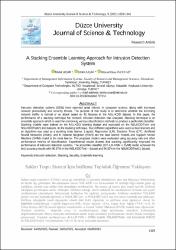A Stacking Ensemble Learning Approach for Intrusion Detection System
Özet
Intrusion detection systems (IDSs) have received great interest in computer science, along with increased network productivity and security threats. The purpose of this study is to determine whether the incoming network traffic is normal or an attack based on 41 features in the NSL-KDD dataset. In this paper, the performance of a stacking technique for network intrusion detection was analysed. Stacking technique is an ensemble approach which is used for combining various classification methods to produce a preferable classifier. Stacking models were trained on the NSLKDD training dataset and evaluated on the NSLKDDTest+ and NSLKDDTest21 test datasets. In the stacking technique, four different algorithms were used as base learners and an algorithm was used as a stacking meta learner. Logistic Regression (LR), Decision Trees (DT), Artificial Neural Networks (ANN), and K Nearest Neighbor (KNN) are the base learner models and Support Vector Machine (SVM) model is the meta learner. The proposed models were evaluated using accuracy rate and other performance metrics of classification. Experimental results showed that stacking significantly improved the performance of intrusion detection systems. The ensemble classifier (DT-LR-ANN + SVM) model achieved the best accuracy results with 90.57% in the NSLKDDTest + dataset and 84.32% in the NSLKDDTest21 dataset.
Kaynak
Düzce Üniversitesi Bilim ve Teknoloji DergisiCilt
9Sayı
4Bağlantı
https://search.trdizin.gov.tr/yayin/detay/498549/a-stacking-ensemble-learning-approach-for-intrusion-detection-systemhttps://hdl.handle.net/20.500.12868/2077


















